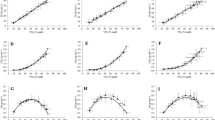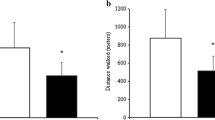Abstract
Treadmill stress testing was carried out according to the Bruce protocol on 14 non-hyperinsulinaemic and 11 hyperinsulinaemic obese children and on 43 age-matched controls. The obese groups were matched for body weight, body composition, physical activity and plasma lipid values. Body composition was calculated on the basis of four skinfold measurements. Exercise duration and physical working capacity corrected for body weight and lean body mass were decreased in the obese children (P<0.01). The hyperinsulinaemic obese children had lower physical working capacities (in absolute values and when corrected for body weight and lean body mass) than the non-hyperinsulinaemic obese children (P<0.05). The exercise period was not significantly different in the two obese subgroups. While fasting plasma insulin levels showed a significant negative correlation with exercise duration and relative physical working capacity in the obese children, the anthropometric parameters did not. It is suggested that the decreased physical fitness in obese children is further aggravated in those with hyperinsulinaemia.
Similar content being viewed by others
Abbreviations
- BW:
-
body weight
- ED:
-
exercise duration in seconds
- HDL-C:
-
high-density lipoprotein cholesterol
- Hi:
-
hyperinsulinaemic
- LBM:
-
lean body mass
- NHi:
-
non-hyper-insulinaemic
- IRI:
-
immunoreactive insulin
References
Breitweser JA, Meyer RA, Tsang RC, Kaplan S (1979) Septal hypertrophy in hyperinsulinemic infants (Abstr). Am J Cardiol 43:366
Brook CGD (1971) Determination of body composition of children from skinfold measurements. Arch Dis Child 46:182–184
Bruce RA, Kusumi F, Hosmer D (1973) Maximal oxygen intake and nomographic assessment of functional aerobic impairment in cardiovascular disease. Am Heart J 85:546–562
Cumming GR, Cumming PM (1963) Working capacity of normal children tested on bicycle ergometer. Can Med Assoc J 88:351–355
Cumming GR, Everatt D, Hastman L (1978) Bruce treadmill test in children: normal values in a clinic population. Am J Cardiol 41:69–75
Dempsey JA, Reddan W, Balke B, Rankin J (1966) Work capacity determinants and physiologic cost of weight-supported work in obesity. J Appl Physiol 21:1815–1820
Durnin JVGA, Rahaman MM (1967) The assessment of the amount of fat in the human body from measurements of skin-fold thickness. Br J Nutr 21:681–689
Elo O, Hirvonen L, Peltonen T, Välimäki I (1965) Physical working capacity of normal and diabetic children. Ann Paediatr Fenn 11:25–31
Galbo H (1983) Hormonal and metabolic adaptation to exercise. Thieme, Stuttgart, pp 30–39, 65–66
Gutgesell HP, Speer ME, Rosenberg HS (1980) Characterization of cardiomyopathy in infants of diabetic mothers. Circulation 61:441–450
Herbert V, Lau KS, Gottlieb CW, Bleicher SI (1965) Coated charcoal immunoassay of insulin. J Clin Endocrinol Metab 25: 1375–1384
Huttunen N-P, Knip M, Paavilainen T (1986) Physical activity and fitness in obese children. Int J Obes 10:519–525
Jeanrenaud B (1979). Insulin and obesity. Diabetologia 17: 133–138
Khan SR, Elkeles RS, Niththyananthan R, Seed M, Wynn V (1982) Analysis of high density lipoprotein subclasses by a precipitation procedure: comparison with preparative ultracentrifuge. Clin Chim Acta 120:49–55
Landsberg L, Young JB (1985) Insulin-mediated glucose metabolism in the relationship between dietary intake and sympathetic nervous system activity. Int J Obes [Suppl 2] 9:63–68
Manicardi V, Camellini L, Bellodi G, Coscelli C, Ferrannini E (1986) Evidence for an association of high blood pressure and hyperinsulinemia in obese man. J Clin Endocrinol Metab 62: 1302–1304
Martin MJ, Horwitz DL, Nattrass M, Granger JF, Rochman H, Ash S (1981) Effects of mild hyperinsulinemia on the metabolic response to exercise. Metabolism 30:688–694
Mocellin R, Rutenfranz J (1971) Investigations of the physical working capacity of the obese children. Acta Paediatr Scand [Suppl] 217:77–79
Modan M, Halkin H, Almog S, Lusky A, Eshkol A, Shefi M (1985) Hyperinsulinemia. A link between hypertension obesity and glucose intolerance. J Clin Invest 75:809–817
Molnàr D, Kardos M, Soltész G, Baranyai Zs (1982) Intravenous glucose tolerance test in childhood obesity: metabolite levels and their reaction to glucose utilization rate (kg). Acta Paediatr Acad Sci Hung 23:127–135
Molnàr D, Varga P, Rubecz I, Hamar A (1985) Food-induced thermogenesis in obese children. Eur J Pediatr 144:27–31
Page M McB, Smith RBW, Watkins PJ (1976) Cardiovascular effects of insulin. Br Med J 1:430–432
Parizkova J, Vaneckova M, Sprynarova S, Vamberova M (1971) Body composition and fitness in obese children before and after special treatments. Acta Paediatr Scand [Suppl] 217: 80–85
Reinkes L, Stolley H, Droese W (1980) Zur Diagnostik von Übernährung und Übergewicht. Ein neues Somatogramm. Monatschr Kinderheilkd 128:662–667
Reybrouck T, Weymans M, Vinckx Y, Stijns H, Vanderschueren-Lodeweyckx M (1987) Cardiorespiratory function during exercise in obese children. Acta Paediatr Scand 76: 342–348
Rowe JW, Young JB, Minaker KL, Stevens AL, Palotta J, Landsberg L (1981) Effect of insulin and glucose infusions on sympathetic nervous system activity in normal man. Diabetes 30:219–225
Sato Y, Shiraishi S, Oshida Y, Ishiguro T, Sakamoto N (1989) Experimental atherosclerosis-like lesions induced by hyperinsulinism in Wistar rats. Diabetes 38:91–96
Schmeider RE, Messerli FH (1987) Obesity hypertension. Med Clin North Am 71:991–1001
Steele BW, Koehler DF, Azar MM, Blaszkowski TP, Kuba K, Dempseg ME (1976). Enzymatic determination of cholesterol in high-density lipoprotein fractions prepared by a precipitation technique. Clin Chem 22:98–101
Stout RW (1985) Overview of the association between insulin and atherosclerosis. Metabolism 34 [Suppl 1]:7–12
Vanden Eynde B, Ghesquiere J, Gerven D van, Vuylsteke-Wauters M, Vande Perre H (1984). Follow-up study of physical fitness in boys aged 10–14 years. In: Ilmarinen J, Välimäki I (eds) Children and sport. Springer, Berlin Heidelberg New York, pp 111–118
Ylitalo VM (1984) Exercise performance and serum lipids in obese schoolchildren before and after reconditioning program. In: Ilmarinen J, Välimäki I (eds) Children and Sport. Springer, Berlin Heidelberg New York, pp 247–254
Zancanato S, Baraldi E, Santuz P, Rigon F, Vido L, Da Dalt L, Zacchello F (1989) Gas exchange during exercise in obese children. Eur J Pediatr 148:614–617
Zinman B, Vranic M, Albisser AM, Liebel BS, Marliss EB (1979) The role of insulin in the metabolic response to exercise in diabetic man. Diabetes [Suppl 1] 28:76–81
Author information
Authors and Affiliations
Rights and permissions
About this article
Cite this article
Molnàr, D., Pòrszàsz, J. The effect of fasting hyperinsulinaemia on physical fitness in obese children. Eur J Pediatr 149, 570–573 (1990). https://doi.org/10.1007/BF01957695
Received:
Accepted:
Issue Date:
DOI: https://doi.org/10.1007/BF01957695




